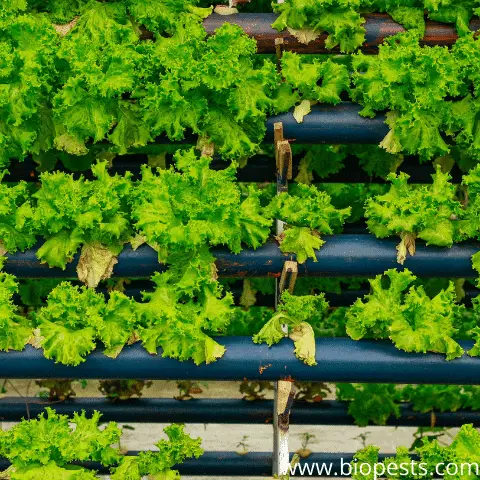Although growing lettuce through hydroponics is less common among agricultural communities, vegetable farmers have used this technique for centuries. Lettuce grown this way is rapidly gaining popularity among healthy eaters who want healthier fresh produce. Due to the absence of soil in hydroponics, lettuce lovers wonder if they need to wash their lettuce.
Hydroponic lettuce doesn’t need to be washed since it is grown in controlled environments with no soil involved. This means hydroponic lettuce eaters have one less step in food preparation and can save more water.
Understanding what hydroponic lettuce is and how it varies from conventionally grown vegetables help growers decide on choosing an agricultural route. The following sections will help you learn more about how hydroponic lettuce is grown and why some take the hydroponic route.
Do You Need To Wash Hydroponic Lettuce?
Hydroponic lettuce is lettuce grown in the absence of soil. Instead, the leafy vegetable is planted in a nutrient solution to supply the required nutrients typically taken from the soil. Through the hydroponic process, owners can harvest a leafy head in just 35 days.
You do not need to wash hydroponic lettuce since no soil is needed to grow it. The vegetable can be safely consumed without washing as it is grown in a controlled environment, where no harmful pesticides are used.
Is Hydroponic Lettuce Safer?
Hydroponic lettuce is not necessarily safer than conventionally grown lettuce. While hydroponic lettuce is free from pesticide and soil residues, the nutrient solution used to grow it may also be ideal habitats for algae and as well as for other greenhouse pests.
Because of this, owners must take proactive measures to prevent infestation in a hydroponic environment.
Advantages of Planting Hydroponic Lettuce
Growing lettuce through hydroponics brings multiple advantages. For instance, the choice of nutrient solution gives growers the flexibility to formulate their own mix without going through the hassle of soil conditioning.

There is also no need to wash the lettuce before eating them. Let’s now look at the other advantages of growing hydroponic lettuce.
Hydroponic Lettuce Can Grow All Year Round
Hydroponic lettuce can grow no matter the season. This is as long as owners can regulate temperature during scorching summers and cold winters.
The controlled environment in hydroponics makes continuous growth possible.
Greenhouse owners do not need to worry about extreme weather as the lettuce will likely grow healthy as long as they get proper nutritional needs and are grown in an ideal environment.
You Can Save More Water
As compared to growing lettuce using conventional agriculture, hydroponic lettuce uses up to 13 times less water.
To make this easier to visualize, producing one kilogram (2.2 lb.) of hydroponic lettuce only uses 20 liters (5.28 gal) of water per year, while growing lettuce the conventional way requires roughly 250 liters (66 gals) of water.
The option to use much less water is critical in locations where water is scarce.
Hydroponic Lettuce Take Up Less Space
Growing lettuce on land requires ten times more area than through hydroponics. As land conversion slowly reduces the space available for agriculture, it is becoming more and more attractive to explore the potential of hydroponics to save space.
A great example is my niece’s terrace. She lives in the city and has a tiny little terrace kissed by the sun most of the day. Instead of planting flowers, she decided to invest in a mini-hydroponic system and take advantage of long hours of sun exposure. She now enjoys a huge harvest in a tiny space!
You Can Plant Hydroponic Lettuce Anywhere You Want
The space and water-saving features of hydroponic lettuce might have already won you over. Still, there’s one more advantage that brings economic and logistical implications: you can plant them right where you need them.
Salad lovers would love to know that your lettuce stops being just a fall or spring crop through hydroponics. Just create the right settings for your own hydroponic greenhouse system, and you’ll be all set.
It won’t matter if it’s freezing winter or burning summer.
However, if you’re doing it for business purposes, another selling point to consider hydroponics in planting your lettuce is knowing you can build your system near distribution points, eliminating the need for transportation costs.
You will still have to assess other cost considerations, especially the energy requirements required by hydroponic systems, but at the very least, transportation could be off the list.
Disadvantages of Planting Hydroponic Lettuce
While opting for hydroponic lettuce has its perks, the high energy and maintenance requirements as compared to conventionally grown lettuce make the choice a little more tricky.
It Requires Dedicated Powered Systems
The artificial environment requires powered systems to maintain optimal settings. This necessity means that the setup is also vulnerable to power outages and may need a generator as backup.
Hydroponic Lettuce Are Vulnerable to Pests
The system’s sensitivity, especially to pests, requires close monitoring of the hydroponic setup. Once parasitic organisms begin latching on a portion of the greenhouse system, the lack of pest control in these systems can backfire.
Pests can quickly spread throughout the entire system, reducing yields, if not completely damaging the crops.
It’s Expensive To Set Up Lettuce Hydroponics
While hydroponic lettuce’s space and water efficiencies correspond to savings, it is also more expensive to set up. If you plan to use hydroponics as a business venture, a more thorough evaluation may be needed.
Still, the energy and maintenance requirements may be compensated by the savings incurred from other aspects in production when you reach a certain scale.
Should I Grow Hydroponic Lettuce?
You should grow hydroponic lettuce if you love eating lettuce and don’t mind planting your own lettuce to avoid commercial lettuce that likely has harmful pesticides.
However, there are several things to consider before growing your own hydroponic lettuce.
The key to finding out whether hydroponics is the way to go is to evaluate your current financial, technical, and production capacity. Large productions may be more beneficial to you, business-wise, but this also means higher risks in case of pest infestation and other unforeseen events.
When done right, if you plan to grow lettuce using hydroponics, you can reap multiple benefits.
However, it is still important to weigh the pros and cons when choosing between different agricultural methods to ensure they are making the most out of the route they opt for.
It is nevertheless a relief to know that weather and space constraints need not stop you from having fresh lettuce for your salad.
Conclusion
Growing hydroponic lettuce comes with many perks, such as reducing water consumption, requiring way less space, doing away with pesticides typically found in soil, and eliminating the need to wash the leafy vegetable before eating.
These advantages, however, also come with significant financial and logistical considerations. You also need to consider possible pests that can impact your lettuce.
Some of the links above are affiliate links, meaning at no additional cost to you, I will earn a commission if you click through and make a purchase.


